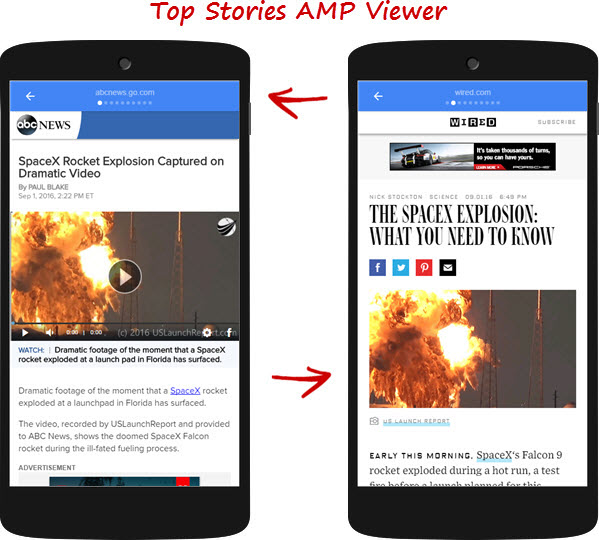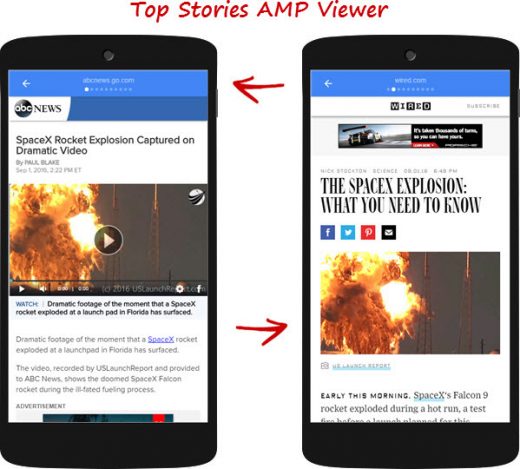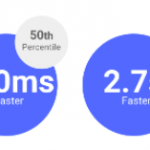Google’s AMP Viewer: the Tinder UX for content?
Google’s hosted AMP viewer takes the risk — and commitment — out of clicking a mobile search result. Contributor Barb Palser discusses what this will mean for publishers.

Users swipe through content from multiple publishers in Google’s Top Stories AMP viewer.
By now most publishers should be aware of Google’s imminent plan to surface Accelerated Mobile Pages (AMPs) throughout mobile search results.
AMP links will no longer be limited to the Top Stories area of mobile results; instead, Google will link to the AMP version of a webpage any time a valid AMP is available. This “blue links” expansion will dramatically increase AMP traffic overall and enable discovery of a rapidly growing universe of non-news and long-tail AMP content.

Today, AMPs appear in the Top Stories area of mobile search results. Soon, Google will link to AMPs in standard search results (aka, “blue links”).
Publishers might not realize that Google won’t just link to AMPs, but will present them in a Google-hosted viewer which is certain to alter user flow and engagement from mobile search.
Google has been upfront about the plan. On August 2, the company offered a preview environment where anyone can see how AMP results in blue links will behave. AMPs will open in the viewer — a blue bar at the top of the screen with a back arrow for returning to search results.
Go to g.co/ampdemo on a mobile device or mobile browser emulator to try it out.

In Google’s demo environment, AMPs open in the Google viewer with an arrow linking back to the search results page.
In fact, a version of the viewer has been live since February when Google started linking to AMPs in the Top Stories section of search results. The Top Stories viewer enables users to swipe through a gallery of AMPs from different sources or return to search results. Think of the Tinder user experience, but for content:

The Top Stories AMP viewer encourages the user to swipe through a gallery of stories from different publishers; in this example, the first story in the viewer is from ABC News, and the second is from Wired.
Instead of clicking from the search results page to a webpage, which might load slowly or not offer what the user is looking for (a costly choice on mobile), the AMP viewer makes it easy to rifle through the offerings of different publishers or bounce back and forth between the results page and fast-loading AMPs without ever leaving Google’s environment. (A user exits the viewer by clicking through a link on an AMP.)
What this means for publishers
It’s no surprise that Google has designed a Google-oriented user experience. Is that necessarily a bad thing? And what are the implications for publishers?
There are a couple of ways to look at it.
If you’re searching for evidence of Google’s master plan to slurp up the entire web, this could fit the narrative. The most prominent navigation choice in the AMP viewer is to return to search results — or in the Top Stories viewer, to swipe for more content from other publishers — instead of continuing a forward path through article links and navigation.
The viewer frame uses valuable real estate at the top of the mobile screen. And Google doesn’t just frame AMP pages in the viewer; it caches them and delivers them from Google’s CDN (with a cross-domain side effect on AMP analytics for common KPIs such as users, sessions and bounce rate). Google’s control of the user experience now extends down a level from the search result to the first pageview.
Here’s another perspective:
The Google viewer makes a user’s experience enormously better. AMPs are a breath of fresh air after sluggish, messy, jerky, resource-taxing webpages — and the ability to flip through a gallery of AMPs is an upgrade to the discovery experience.
Google’s cache gives publishers a free, high-performance CDN on Google infrastructure and enables Google to enforce AMP validation for quality control. Valid AMPs are delivered with all of the publisher’s content, analytics, ads and other business elements intact.
Moreover, while it stings to be the publisher whose article is swiped past in the Top Stories viewer, it’s nice to be the publisher whose article is swiped to. In other words, for the second, third or fourth article in AMP results, the viewer may improve the odds of discovery.
Then it’s up to the publisher to optimize that “first impression” by delivering a page that holds the user’s attention and drives onward engagement. Depending on the publisher’s execution, AMPs can be a compelling content and brand experience, or an engagement dead-end.
(Google could also tune its execution; publishers might be pleased if the viewer frame took up a little less space, or if the swipe interface in the blue links viewer would surface additional content from each publisher.)
Initially, the AMP viewer will be a Rorschach test, subject to perception. It’ll be tricky to quantify the net impact of the viewer on audience due to the analytics disparities and the nascency of the format.
Also, most publishers are far from optimizing their AMPs, which may be more influential on engagement than anything Google does.
One thing is evident: AMP isn’t just a format for fast mobile pages, but a framework for a new type of user experience.
Some opinions expressed in this article may be those of a guest author and not necessarily Marketing Land. Staff authors are listed here.
Marketing Land – Internet Marketing News, Strategies & Tips
(44)














